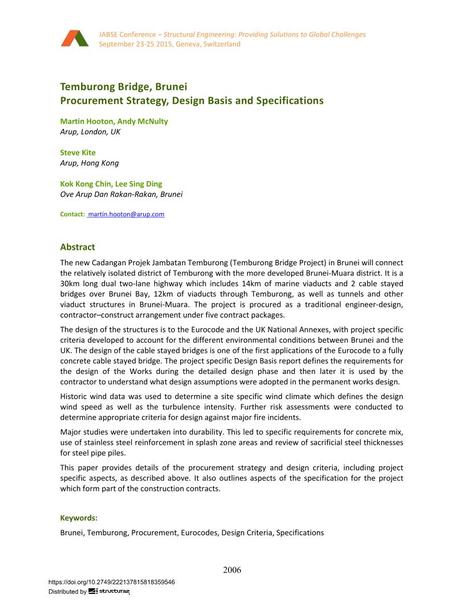Temburong Bridge, Brunei – Procurement Strategy, Design Basis and Specifications

|
|
|||||||||||
Bibliografische Angaben
| Autor(en): |
Steve Kite
(Arup, Hong Kong)
Martin Hooton (Arup, London, UK) Andy McNulty (Arup, London, UK) Kok Kong Chin (Ove Arup Dan Rakan-Rakan, Brunei) Lee Sing Ding (Ove Arup Dan Rakan-Rakan, Brunei) |
||||
|---|---|---|---|---|---|
| Medium: | Tagungsbeitrag | ||||
| Sprache(n): | Englisch | ||||
| Tagung: | IABSE Conference: Structural Engineering: Providing Solutions to Global Challenges, Geneva, Switzerland, September 2015 | ||||
| Veröffentlicht in: | IABSE Conference Geneva 2015 | ||||
|
|||||
| Seite(n): | 2006-2013 | ||||
| Anzahl der Seiten (im PDF): | 8 | ||||
| Jahr: | 2015 | ||||
| DOI: | 10.2749/222137815818359546 | ||||
| Abstrakt: |
The new Cadangan Projek Jambatan Temburong (Temburong Bridge Project) in Brunei will connect the relatively isolated district of Temburong with the more developed Brunei-Muara district. It is a 30km long dual two-lane highway which includes 14km of marine viaducts and 2 cable stayed bridges over Brunei Bay, 12km of viaducts through Temburong, as well as tunnels and other viaduct structures in Brunei-Muara. The project is procured as a traditional engineer-design, contractor–construct arrangement under five contract packages. The design of the structures is to the Eurocode and the UK National Annexes, with project specific criteria developed to account for the different environmental conditions between Brunei and the UK. The design of the cable stayed bridges is one of the first applications of the Eurocode to a fully concrete cable stayed bridge. The project specific Design Basis report defines the requirements for the design of the Works during the detailed design phase and then later it is used by the contractor to understand what design assumptions were adopted in the permanent works design. Historic wind data was used to determine a site specific wind climate which defines the design wind speed as well as the turbulence intensity. Further risk assessments were conducted to determine appropriate criteria for design against major fire incidents. Major studies were undertaken into durability. This led to specific requirements for concrete mix, use of stainless steel reinforcement in splash zone areas and review of sacrificial steel thicknesses for steel pipe piles. This paper provides details of the procurement strategy and design criteria, including project specific aspects, as described above. It also outlines aspects of the specification for the project which form part of the construction contracts. |
||||
